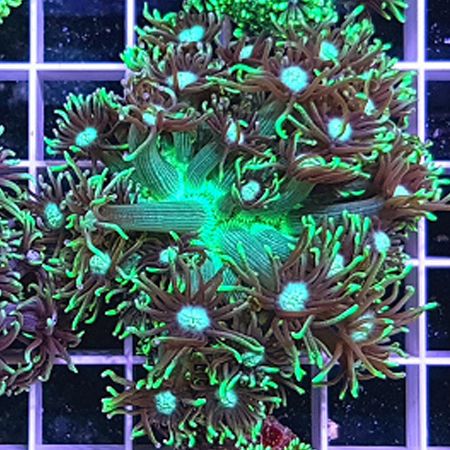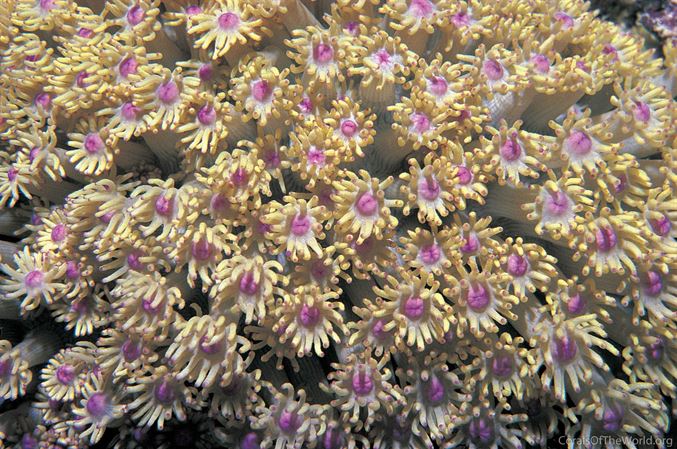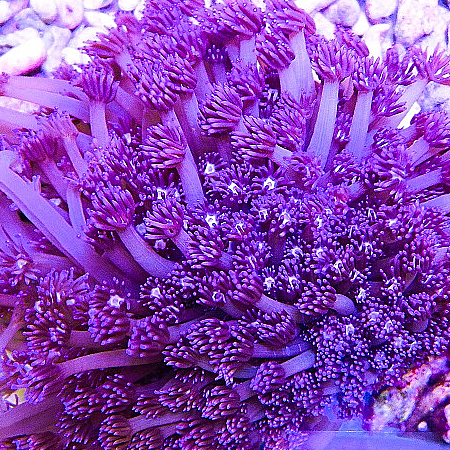
𝐆𝐨𝐧𝐢𝐨𝐩𝐨𝐫𝐚 𝐃𝐞𝐦𝐲𝐬𝐭𝐢𝐟𝐢𝐞𝐝: 𝐄𝐯𝐞𝐫𝐲𝐭𝐡𝐢𝐧𝐠 𝐘𝐨𝐮 𝐍𝐞𝐞𝐝 𝐭𝐨 𝐊𝐧𝐨𝐰
Introduction
Goniopora corals have come a long way from their reputation as "impossible to keep." These stunning flower-like corals are now thriving in reef tanks thanks to aquacultured varieties, better understanding, and just a bit of patience. Known for their hypnotic movement and wild range of colors, Goniopora (aka Flowerpot corals) can be a showstopper in the right setup.
Let me walk you through everything you need to know to keep your Goni swaying happily—from lighting and flow to feeding and troubleshooting.
If you would like to watch our video on Goniopora click here
What Is Goniopora?
- Type: Large Polyp Stony (LPS) Coral
- Scientific name: Goniopora spp.
- Common names: Flowerpot Coral, Daisy Coral, Ball Coral
- Native habitat: Found throughout the Indo-Pacific region, especially in sheltered lagoons, reef slopes, and turbid nearshore areas with moderate water movement. Some species prefer deeper, dimmer water, while others thrive in sunlit shallows.
- Signature look: One of the most visually captivating corals in the hobby. Goniopora feature dozens—sometimes hundreds—of long, flower-like polyps that sway rhythmically with the current. Each polyp ends in a rounded tip, often colored in contrasting hues like neon green, red, pink, or blue, giving them that “daisy” or “pom-pom” appearance.
Tamara’s Pro Tip: Not all Gonis are created equal. Ask your LFS or vendor which species you're buying—some are dramatically easier than others (see below).
Species & Difficulty
Goniopora stokesi
One of the most frequently seen species in the hobby—and also one of the most misunderstood. G. stokesi is easily recognizable thanks to its long, flowing polyps (sometimes reaching 2–3 inches in extension) and brilliant green coloration. However, this species is notorious for being temperamental in captivity. It tends to do best in well-established tanks with low to moderate light (PAR 80–150), moderate indirect flow, and very stable water parameters. Many reefers have had success with target feeding and supplementing with manganese or iron.

Photo Credit: Ocean Store
Tamara’s Pro Tip: G. stokesi is like that high-maintenance plant friend—we love the look, but you’ve gotta stay on top of care or it will ghost you without warning.
Goniopora columna
This species tends to form more elongated, column-like skeletons and is often less temperamental than stokesi. G. columna enjoys moderate light (PAR 100–200), moderate flow, and stable nutrients. It seems to tolerate the occasional swing better than other species, making it a good mid-level option for those with some LPS experience. Polyp extension is shorter than stokesi but still very graceful and full of motion.

Photo Credit: https://marinebiodiversity.org
Tamara’s Pro Tip: A great pick if you want something a little showy but not quite as demanding. Think of it as a “step-up” Goni.
Goniopora lobata
A classic, dome-shaped species that many hobbyists report as being more adaptable than other Goniopora. It typically comes in subdued colors (like mint green, dusty pink, or brown), but don’t let that fool you—when healthy, the polyp motion and density are stunning. This species can handle moderate light and flow, and often doesn’t require target feeding to thrive. It’s frequently found in more turbid or nutrient-rich waters in the wild, which may explain its tolerance for mild instability.

Photo Credit: Wikipedia
Tamara’s Pro Tip: This is your “recovery Goni”—if you’ve struggled with stokesi, give lobata a shot.
Goniopora tenuidens
One of the newer hobby darlings, G. tenuidens is showing up more frequently in aquaculture facilities—and that’s a good thing. This species is often a bit more compact, with shorter but densely packed polyps that come in bright neon colors. Because it’s usually aquacultured, it’s already adapted to captive conditions, making it a fantastic choice for newer reefers. It handles moderate lighting and flow and tends to recover more quickly from stress.

Photo Credit: Ocean Store
Tamara’s Pro Tip: If you’re a Goni beginner, tenuidens is the VIP pass to that flowerpot coral lifestyle without the heartbreak.
Color Morphs and What They Mean for Care
Goniopora corals come in an incredible range of colors, and while it’s easy to fall in love with the flashiest frag on the rack, it’s good to know that some morphs are a little more demanding than others. Here’s a quick breakdown of the common types you’ll run into:
1. Bright Green:
Often the hardiest and most forgiving of the bunch. Green Gonis are commonly G. lobata or G. stokesi, and tend to do well in a range of light and nutrient conditions.
2. Bubblegum Pink:
A fan favorite. Usually found in G. tenuidens or G. columna, and often aquacultured. These pinks can be a little pickier about light intensity—too much can cause fading, while too little may reduce polyp extension.
3. Rainbow and Gold-Tipped Morphs:
Absolutely stunning… and often divas. These morphs usually command top dollar and top-tier conditions. Stable parameters, moderate light (PAR 100–150), and gentle indirect flow are essential to keep those colors from fading. These morphs tend to stress more easily if neglected.
4. Teal, Lavender, and Multicolor:
These showy hybrids are becoming more available through aquaculture. They’re often grafted or selectively bred. They require balanced nutrients and benefit from occasional feeding to maintain color vibrancy and tissue health.
Tamara’s Pro Tip: If you’re just getting into Goniopora, start with greens or pinks before chasing rainbows. The bolder the color, the more likely it was raised under controlled conditions—and the more likely it is to complain if your tank parameters fluctuate.
Goniopora vs. Alveopora: What’s the Difference?
These two corals are often mistaken for one another—and it’s easy to see why. They both have flower-like polyps, extend beautifully into the current, and come in a variety of stunning colors. But there are a few key differences that every hobbyist should know before choosing between them:
1. Tentacle Count:
One of the easiest ways to tell them apart is by counting the tentacle tips on a single polyp.
Goniopora: Typically have around 24 tentacles per polyp, giving them a fuller, bushier look.
Alveopora: Tend to have 12 tentacles per polyp, which gives them a more delicate, starburst-like appearance.
2. Care and Hardiness:
Alveopora: Are generally more forgiving, tolerate a wider range of conditions, and adapt well to moderate flow and light. They’re an excellent stepping stone if you’re looking to work your way up to keeping Goniopora.
Goniopora: Tend to be more finicky about stable parameters, flow, and feeding. They require more attention and reward it with a dramatic presence and movement in the tank.
3. Growth Form and Texture:
Goniopora: Often form dense mats or hemispherical colonies, and the polyps can have a slightly thicker, meatier base.
Alveopora: Colonies tend to be a bit more open and delicate in appearance, with thinner, more flexible tentacles.
Tamara’s Pro Tip: If you’re not quite ready to dive into Goniopora but love the look, give Alveopora a try first. It’s the perfect “training wheels” coral before you take on the more demanding flowerpots.
Species Requirements
Placement in the Tank
1. Ideal Location:
- Goniopora corals tend to do best on the sand bed or low-to-mid-level rockwork. This placement allows for more stable lighting and water flow—two critical elements for their health.
- Room to Breathe: These corals expand dramatically, often doubling or tripling in size from their skeletal base once fully open. If placed too close to rocks or other corals, their polyps may rub, retract, or become damaged over time.
2. Lighting Requirements
- Lighting Needs: Goniopora corals thrive under moderate to moderately high light. They’re not true low-light corals, but they definitely don’t like being under spotlight-level intensity either.
- Ideal PAR Range: Aim for 100–200 PAR, depending on the species and color morph. This range supports healthy photosynthesis without overwhelming the coral’s tissue.
- Signs of Too Much Light: If the polyps start looking short, stubby, or retracted, that’s usually a sign they’re getting too much intensity. Over time, excessive light can cause bleaching—especially in the more delicate rainbow or pastel morphs.
- Signs of Too Little Light: If your Goniopora isn’t growing, seems dull in color, or retracts early in the day, you may want to gradually increase light over a week or two.
- Lighting Types: They do well under T5, LED, or hybrid fixtures. The key is even coverage—hotspots and shadow zones aren’t ideal.
Tamara’s Pro Tip: Goniopora will tell you how they feel about your light. If they’re reaching up like flowers to the sun, they want more. If they’re hunched and sulking, they’re over it—literally.
3. Flow Preferences
- Preferred Flow: Goniopora corals thrive in low to moderate, indirect flow. Think of a calm reef lagoon—not a crashing wave zone. You want just enough movement to keep their long tentacles gently swaying and to prevent detritus from settling on their tissue.
- Why Flow Matters: Too much direct flow can cause polyps to retract, tissue damage, or even slow starvation if feeding tentacles can’t fully extend. On the flip side, stagnant areas can lead to detritus buildup and bacterial issues.
- Placement Tips: Never place Goniopora directly in front of a powerhead or high-output return nozzle. Instead, tuck them into a spot where they receive bounced or cross-flow—enough to keep them clean, but not enough to whip them around.
- Adjust Based on Behavior: When happy, their tentacles move like soft seagrass in a breeze. If they’re whipping around like inflatable tube men in a car dealership ad, it’s time to reduce flow or reposition.
Tamara’s Pro Tip: Look for a gentle sway like seagrass in the breeze. If they look like they’re in a hurricane, dial it back.
Feeding & Nutrition
1. Photosynthetic, but hungry: Goniopora corals host zooxanthellae, which means they get some of their energy from light. But to really thrive and color up, they benefit tremendously from supplemental feeding—especially in low-nutrient (ULNS) systems.
2. How often to feed: Aim for 2–3 times per week. Regular feeding encourages polyp extension, faster growth, and richer coloration, especially in high-demand morphs like rainbows and gold-tips.
3. Best foods to use:
-
- Reef Roids – A popular powdered coral food that Gonis respond well to.
- Benepets – Nutrient-dense pellets that work great if you crush them finely.
- Goniopower – Powdered Goniopora food specialially formulated for their needs.
- Phytoplankton – Adds diversity to your feedings and benefits other filter feeders too.
- Rotifers and microplankton – Excellent for fine-tentacled varieties; easily captured by extended polyps.
4. Feeding technique: Turn off your return pump and powerheads to keep food suspended and give the coral time to capture it. Use a turkey baster, pipette, or feeding syringe to gently cloud the food around the tentacles rather than blasting it directly.
Tamara’s Pro Tip: Shut down the pumps, dim the lights, and give them a nice dusting of powdered food. You’ll see those tentacles grab and pull it in like they’re at a buffet.
Growth Rates
1. Moderate growers with mood swings:
- Goniopora aren’t the fastest LPS on the block, but when happy, they can surprise you with steady growth. Under ideal conditions, some aquarists report up to ½ inch of skeletal growth per month, especially with regular feeding and stable water chemistry.
2. Growth speed varies by species:
- Goniopora tenuidens and G. lobata tend to be faster growers and more forgiving of minor parameter swings.
- Goniopora stokesi is slower and more temperamental, often taking longer to adjust before putting on visible size.
- Wild colonies typically grow slower than aquacultured ones, which are already adapted to tank life.
3. Feeding makes a difference:
Gonis that are target fed 2–3 times per week almost always show better growth compared to unfed counterparts. Think of it as giving them a protein shake between workouts.
4. Expect growth plateaus:
It’s not uncommon for Goniopora to go through periods where they just… stop. They might sulk for weeks, then suddenly explode with new polyps once conditions shift slightly in their favor. Be patient and resist the urge to move them constantly.
Tamara’s Pro Tip: If your Goni hasn’t grown in a while, check your nutrients—low nitrates and phosphates can stall their metabolism. Sometimes all they need is a tiny bit more food or a touch of nitrate to kick back into gear.
Compatibility
1. Neighbor Awareness and Compatibility
Goniopora are peaceful corals by nature, but they are also delicate and territorial. While they don’t send out long sweeper tentacles like some LPS corals, they can still sting neighboring corals if they feel encroached upon—especially when fully expanded. Their soft, fleshy tissue is easily irritated by contact, making smart placement a big part of long-term success.
2. Coral neighbors to avoid:
- Euphyllia (hammer, frogspawn, torch corals) – notorious for their long, stinging tentacles that can damage Goniopora tissue.
- Galaxea – highly aggressive with long sweepers that can lash out at nearby colonies.
- Fast-growing mushrooms and zoanthids – these can quickly overtake space and irritate the Goni with constant contact.
- Encrusting corals like GSP (green star polyps) – their fast spread can overwhelm slower-growing Gonis.
3. Fish compatibility:
- Generally safe with peaceful, reef-safe fish.
- Avoid aggressive fish that might nip at coral polyps, such as large angelfish or certain wrasses.
- Watch for clownfish trying to host the Goni—while cute, this can stress the coral if it’s not used to the attention.
Tamara’s Pro Tip: Goniopora need breathing room. Picture them like introverts at a party—they’ll thrive if you give them a little personal space. Leave at least 3–4 inches between them and any other coral neighbors, and you’ll have a much happier flowerpot.
Water Parameters for Success
-
Temp: 75–78°F
-
Salinity: 1.025–1.026
-
pH: 8.1–8.4
-
Alkalinity: 8–10 dKH
-
Calcium: 400–450 ppm
-
Magnesium: 1250–1350 ppm
-
Nitrate: 5–10 ppm
-
Phosphate: 0.03–0.1 ppm
Troubleshooting Common Problems
1. Problem: Polyps Not Extending
Cause: Excessive flow, poor lighting, or unstable water parameters (especially alkalinity swings)
Solution:
-
- Move the coral to an area with gentle, indirect flow—no direct powerhead blasting
- Check PAR levels; aim for 100–200 depending on the species
- Test alkalinity, calcium, and magnesium—Gonis sulk when chemistry swings
- Avoid abrupt changes like sudden lighting upgrades or major aquascape shifts
2. Problem: Tissue Recession or Shrinking Flesh
Cause: Inadequate nutrition, low nutrients, or bacterial infections
Solution:
-
- Increase supplemental feeding to 2–3 times per week with coral foods like Reef Roids or Benepets
- Ensure your nitrate is in the 5–10 ppm range and phosphate around 0.03–0.1 ppm—ultra-low nutrients can starve Gonis
- If recession is rapid or localized, consider a coral-safe dip like iodine or Coral RX to rule out infection or pests
3. Problem: Dull or Brown Coloration
Cause: Low light levels or poor nutrient availability
Solution:
-
- Gradually increase lighting if PAR is below 80—go slow to avoid light shock
- Dose aminos or target-feed a small amount of coral food to boost color
- Make sure your filtration isn’t stripping the tank of all nutrients—some Gonis fade in “too clean” systems
4. Problem: Polyp Extension Shrinks Over Time
Cause: Accumulated stress from unstable parameters, poor flow, or aggression from nearby corals
Solution:
-
- Double-check for coral warfare—Gonis don’t like close neighbors, especially torches or zoas
- Reevaluate flow; a change in pump placement or tank layout might have shifted water movement
- Rebalance your major parameters (alkalinity 8–10 dKH, calcium 400–450 ppm, magnesium 1250–1350 ppm)
5. Problem: Sudden Decline After Fragging or Shipping
Cause: Physical stress or delayed acclimation response
Solution:
-
- Give the coral time to recover in low flow and low light for a few days
- Don’t feed immediately—wait 48 hours post fragging or shipping
- If tissue damage is visible, dip as a precaution and monitor closely for infection
Tamara’s Pro Tip: If you tune into their subtle signs—short polyps, retracted tissue, dulled color—you’ll get the feedback you need. Just don’t overcorrect. Small, slow changes = Happy Gonis.
FAQs
1. Can I keep multiple Goniopora together?
Yes, Goniopora are generally peaceful with their own kind and can be placed near each other, especially if they’re the same species. However, they still appreciate personal space. Overlapping tissue can cause irritation, especially if one colony is stronger or expanding more quickly. Give each Goni at least a few inches of room to open fully without touching.
Tamara’s Pro Tip: If you want a colorful Goni garden, keep each frag on its own rock island. This makes it easier to reposition them later if needed and reduces the chance of crowding.
2. Can Goniopora recover from damage or recession?
In many cases, yes. Goniopora are surprisingly resilient when given the right care. If you notice tissue recession or damage:
- Remove the source of stress (too much flow, aggressive neighbors, poor parameters).
- Feed lightly but consistently to support tissue regeneration.
- Keep nutrients slightly elevated (5–10 ppm nitrate, 0.03–0.1 ppm phosphate).
- Maintain high water quality and avoid drastic parameter swings.
If infection is suspected, a coral dip in iodine or a broad-spectrum coral treatment can help.
3. Do Goniopora need to be fed, or can they survive on light alone?
They are photosynthetic and will survive under adequate lighting, but feeding dramatically improves growth, color, and polyp extension. Regular target feeding with products like Reef Roids, Benepets, or finely blended frozen foods brings out their best performance.
In nutrient-poor systems or ultra-clean setups, feeding becomes even more important to avoid tissue thinning and pale coloration.
4. Are Goniopora good for beginners?
Some species, yes! While Goniopora used to be considered difficult, many aquacultured varieties today are much more forgiving. Species like Goniopora tenuidens and lobata are great introductions for intermediate hobbyists ready to try something a bit more rewarding than typical LPS.
Avoid wild-collected or unidentified Goniopora unless you’re confident in your system’s stability.
5. What are signs that my Goniopora is unhappy?
Watch for:
- Polyps that remain tightly retracted for multiple days
- Loss of vibrant color or a browned-out appearance
- Tissue recession at the base or skeleton exposure
- Floppy, limp tentacles instead of upright, active ones
These signs often indicate issues with lighting, flow, nutrients, or aggression from other corals.
6. How can I frag Goniopora?
Fragging should only be done on healthy, well-established colonies. Use a diamond band saw or coral shears to carefully cut through the skeleton between polyps. Make sure each frag has at least 2–3 full polyps. Let the frags recover in low-flow and low-light for a few days, and avoid handling them unnecessarily during healing.
Conclusion
Goniopora corals may have been considered challenging once upon a time, but with aquacultured varieties and more accessible care knowledge, they’re now a star player in many reef tanks. Respect their needs, feed them well, and don’t rush them. When they’re happy, they’ll put on a flowy, flower-filled show that’s hard to beat.
Once you get your first Goni thriving, it’s hard not to start a collection. You’ve been warned!
Happy Reefing!
References:
-
Borneman, Eric H. Aquarium Corals: Selection, Husbandry, and Natural History. TFH Publications, 2001.
-
Calfo, Anthony, and Robert Fenner. Reef Invertebrates: An Essential Guide to Selection, Care, and Compatibility. Reading Trees Publications, 2003.
-
Delbeek, J. Charles, and Julian Sprung. The Reef Aquarium: A Comprehensive Guide to the Identification and Care of Tropical Marine Invertebrates. Vol. 1, Ricordea Publishing, 1994.
-
Fenner, Robert M. The Conscientious Marine Aquarist: A Commonsense Handbook for Successful Saltwater Hobbyists. TFH Publications, 2008.







.png)